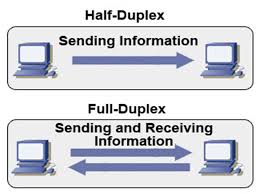Half-duplex
A simple illustration of a half-duplex communication system
A half-duplex (HDX) system provides communication in both directions, but only one direction at a time (not simultaneously). Typically, once a party begins receiving a signal, it must wait for the transmitter to stop transmitting, before replying.
An example of a half-duplex system is a two-party system such as a walkie-talkie, wherein one must use "over" or another previously designated keyword to indicate the end of transmission, and ensure that only one party transmits at a time, because both parties transmit and receive on the same frequency. A good analogy for a half-duplex system would be a one-lane road with traffic controllers at each end, such as a two-lane bridge under re-construction. Traffic can flow in both directions, but only one direction at a time, regulated by the traffic controllers.
Half-duplex systems are usually used to conserve bandwidth, since only a single communication channel is needed, which is shared alternately between the two directions. For example, a walkie-talkie requires only a single frequency for bidirectional communication, while a cell phone, which is a full-duplex device, requires two frequencies to carry the two simultaneous voice channels, one in each direction.
In automatically run communications systems, such as two-way data-links, the time allocations for communications in a half-duplex system can be firmly controlled by the hardware. Thus, there is no waste of the channel for switching. For example, station A on one end of the data link could be allowed to transmit for exactly one second, then station B on the other end could be allowed to transmit for exactly one second, and then the cycle repeats.
In half-duplex systems, if more than one party transmits at the same time, a collision occurs, resulting in lost messages.
Full-duplex
A simple illustration of a full-duplex communication system. Full-duplex is not common in handheld radios as shown here due to the cost and complexity of common duplexing methods, but is used in telephones, cellphones and cordless phones.
A full-duplex (FDX) system, or sometimes called double-duplex, allows communication in both directions, and, unlike half-duplex, allows this to happen simultaneously. Land-line telephone networks are full-duplex, since they allow both callers to speak and be heard at the same time, with the transition from four to two wires being achieved by a hybrid coil in a telephone hybrid. Modern cell phones are also full-duplex.
A good analogy for a full-duplex system is a two-lane road with one lane for each direction. Moreover, in most full-duplex mode systems carrying computer data, transmitted data does not appear to be sent until it has been received and an acknowledgment is sent back by the other party; that way, such systems implement reliable transmission methods.
Two-way radios can be designed as full-duplex systems, transmitting on one frequency and receiving on another; this is also called frequency-division duplex. Frequency-division duplex systems can extend their range by using sets of simple repeater stations because the communications transmitted on any single frequency always travel in the same direction.
Full-duplex Ethernet connections work by making simultaneous use of two physical twisted pairs inside the same jacket, which are directly connected to each networked device: one pair is for receiving packets, while the other pair is for sending packets. Some types of Ethernet, for example Gigabit Ethernet, use two twisted pairs per direction. This effectively makes the cable itself a collision-free environment and doubles the maximum total transmission capacity supported by each Ethernet connection.
Full-duplex has also several benefits over the use of half-duplex. First, there are no collisions so time is not wasted by having to retransmit frames. Second, full transmission capacity is available in both directions because the send and receive functions are separate. Third, since there is only one transmitter on each twisted pair, stations (nodes) do not need to wait for others to complete their transmissions.
Some computer-based systems of the 1960s and 1970s required full-duplex facilities, even for half-duplex operation, since their poll-and-response schemes could not tolerate the slight delays in reversing the direction of transmission in a half-duplex line.

